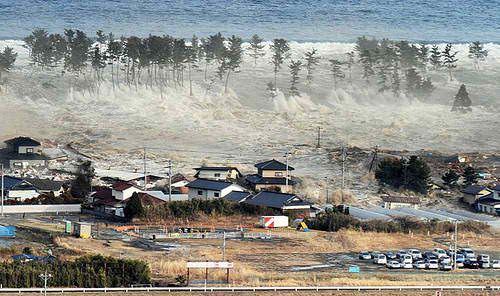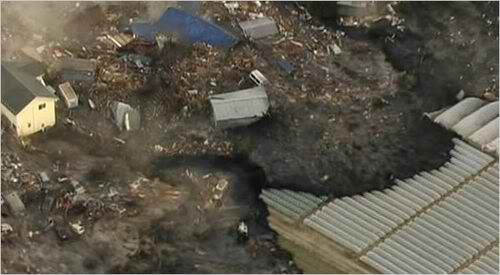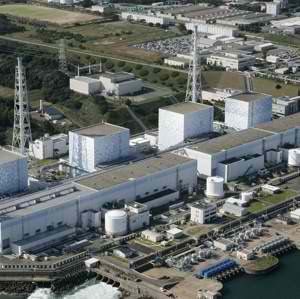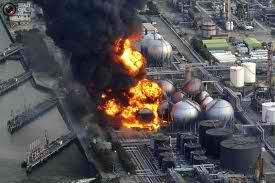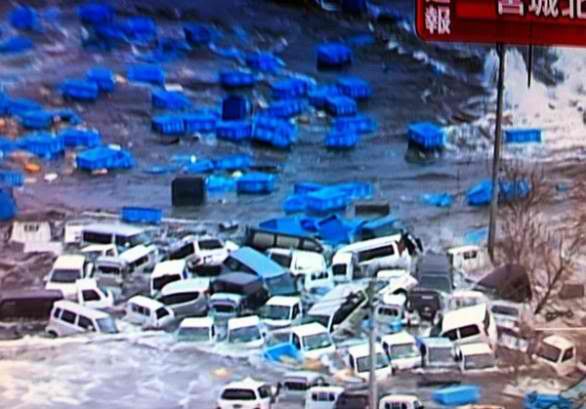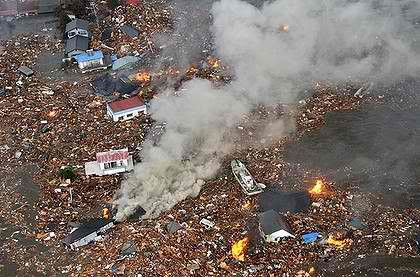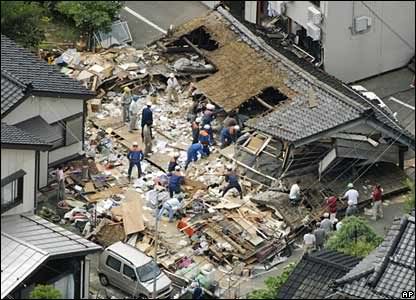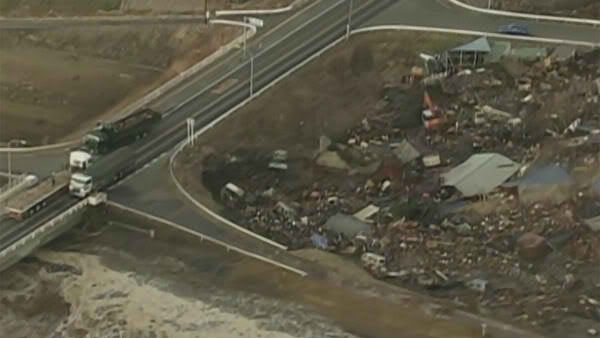(AFP, Reuters) TOKYO, Japan – The official number of dead and missing after a devastating earthquake and tsunami that flattened Japan's northeast coast has passed 13,000, police said Thursday, but reports hinted at a much higher toll.
This developed as operators of a quake-crippled Fukushima nuclear plant in Japan dumped water on overheating reactors on Thursday while the United States expressed growing alarm about leaking radiation and said it was chartering aircraft to help Americans leave the country.
The number of confirmed dead from Friday's twin disasters stood at 5,178, while the official number of missing remained at 8,606, the national police agency said in its latest update.
A total of 2,285 people were injured in the disaster.
But reports continued to come in which indicated that the final toll could be much higher.
The mayor of the coastal town of Ishinomaki in Miyagi prefecture said late Wednesday that the number of missing there was likely to hit 10,000, Kyodo News reported.
On Saturday, public broadcaster NHK reported that around 10,000 people were unaccounted for in the port town of Minamisanriku in the same prefecture.
Amid a mass rescue effort there were grim updates indicating severe loss of life along the battered east coast of Honshu island, where the monster waves destroyed or damaged more than 55,380 homes and other buildings.
Race against time
Engineers were rushing against time to run in a power line off the main grid to fire up the water pumps needed to cool two reactors and the spent fuel rods considered most at risk.
While Japanese officials were scrambling with a patchwork of fixes at the facility, the top US nuclear regulator warned that reactor No.4's cooling pool for spent fuel rods may have run dry and another was leaking.
“There is no water in the spent fuel pool and we believe that radiation levels are extremely high, which could possibly impact the ability to take corrective measures," Gregory Jaczko, head of the Nuclear Regulatory Commission, told a US House Energy and Commerce subcommittee hearing.
“It would be very difficult for emergency workers to get near the reactors. The doses they could experience would potentially be lethal doses in a very short period of time.”
The plant operator said it believed the No.4 reactor spent fuel pool still had water as of Wednesday.
US officials took pains not to criticize the Japanese government, which has shown signs of being overwhelmed by the crisis, but Washington's actions indicated a divide with the Japanese about the perilousness of the situation.
“The worst-case scenario doesn't bear mentioning and the best-case scenario keeps getting worse,” Perpetual Investments said in a note on the crisis.
Japan said the United States would fly a high-altitude drone over the stricken complex to gauge the situation, and had offered to send nuclear experts.
A State Department official said flights would be laid on for Americans to leave and family of embassy staff had been authorized to leave if they wanted.
Health experts said panic over radiation leaks from the Daiichi plant, Christaround 240 km (150 miles) north of Tokyo, was diverting attention from other life-threatening risks confronting survivors of last Friday's 9.0-magnitude earthquake and tsunami, such as cold weather, heavy snow in parts and access to fresh water.
The head of the world's nuclear watchdog said it was not accurate to say things were “out of control” in Japan, but the situation was “very serious,” with core damage to three units at the plant.
However, Sebastian Pflugbeil, president of the private German-based Society for Radiation Protection, said Japan's efforts to pull the Fukushima plant back from the brink signaled “the beginning of the catastrophic phase.”
We have to pray
“Maybe we have to pray,” he said, adding that a wind blowing any nuclear fallout east into the Pacific would limit any damage for Japan's 127 million people in case of a meltdown or other releases, for instance from spent fuel storage pools.
The latest images from the plant showed severe damage to some of the buildings after several explosions.
A stream of gloomy warnings and reports on the Japan crisis from experts and officials around the world triggered a sharp fall in US financial markets, with all three major stock indexes slumping on fears of slower worldwide growth.
In a sign of the degree of concern among top policymakers, one G7 central banker, who asked not to be identified, said he was “extremely worried” about the wider effects of the crisis in Japan, the world's third-largest economy.
“I think the world economy is going to go right down and it has happened at a time when financial markets are still very fragile,” he said.
G7 finance ministers will hold a conference call later on Thursday to discuss steps to help Japan cope with the financial and economic impact of the disaster, a source said.
Radiation level falls
Japan's nuclear agency said radiation levels at the plant “continued to fall,” but the government appealed to private companies to help deliver supplies to tens of thousands of people evacuated from a 30-km (18-mile) zone around the complex.
Tokyo Electric Power Co. (TEPCO) officials said bulldozers attempted to clear a route to the reactor so fire trucks could gain access and try to cool the facility using hoses.
High radiation levels on Wednesday prevented a helicopter from dropping water into No. 3 to try to cool its fuel rods after an earlier explosion damaged its roof and cooling system.
Another attempt on Thursday appeared to be partially successful, with two of four water drops over the site hitting their mark. The giant, twin-blade aircraft have to make precisely timed flyovers and drops to avoid the brunt of the radiation.
No. 3 high priority
The plant operator described No. 3 – the only reactor that uses plutonium in its fuel mix – as the “priority.” Experts described plutonium as a very nasty isotope that could cause cancer if very small quantities were ingested.
The situation at No. 4 reactor, where the fire broke out, was “not so good,” TEPCO said on Wednesday, while water was being poured into reactors No.5 and 6, indicating the entire six-reactor facility was now at risk of overheating.
Scores of flights to Japan have been halted or rerouted and air travelers are avoiding Tokyo for fear of radiation.
On Thursday, the US embassy in Tokyo urged citizens living within 50 miles of the Daiichi plant to evacuate or remain indoors “as a precaution,” while Britain's foreign office urged citizens “to consider leaving the area.”
The warnings were not as strong as those issued earlier by France and Australia, which urged nationals in Japan to leave the country. Russia said it planned to evacuate families of diplomats on Friday.
At its worst, radiation in Tokyo has reached 0.809 microsieverts per hour this week, 10 times below what a person would receive if exposed to a dental x-ray.
But many Tokyo residents stayed indoors, usually busy streets were nearly deserted and many shops and offices were closed.
One bank, Mizuho, said all its automatic teller machines in the country briefly crashed. It doubted the problem was connected to the earthquake or power cuts, but it triggered a rush to withdraw cash from machines in the capital.
Nuclear fear
In a demonstration of the qualms about nuclear power that the crisis has triggered around the globe, China announced that it was suspending approvals for planned plants and would launch a comprehensive safety check of facilities.
China has about two dozen reactors under construction and plans to increase nuclear electricity generation about seven-fold over the next 10 years.
Russia said nuclear power was safe provided power stations were built in the right place and designed and managed properly, but ordered checks at nuclear facilities.
In Japan, the plight of hundreds of thousands left homeless by the earthquake and tsunami worsened following a cold snap that brought heavy snow to worst-affected areas.
Supplies of water and heating oil are low at evacuation centers








